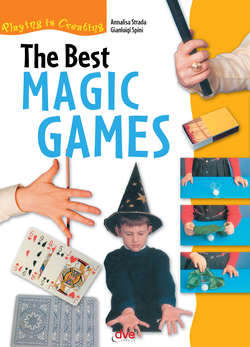Читать книгу The Best Magic Games - Gianluigi Spini - Страница 4
Games with the magic wand
ОглавлениеThe flying magic wand
EFFECT
The wand stays near the magician’s hand although his fingers do not hold it.
NECESSARY MATERIAL
• A magic wand
• A small very fine rubber band
PREPARATION
Place the rubber band on the base of your middle and ring finger
PERFORMANCE
Simulate that you placed the wand in the palm of your closed hand, and slide it over the rubber band so that it is maintained in equilibrium. Move your hand and fingers to show that the wand has attached itself to your hand on its own (fig. A-B). The more you move your hand, the greater the effect will be and the lower the chances that the light will reflect on the rubber band.
The semi-mobile wand
EFFECT
The magic wand levitates itself towards the magician’s fist.
NECESSARY MATERIAL
• Thin card
• Two metal plates or two buttons
• A rubber band
PREPARATION
Join the two plates or the two buttons with a rubber band of a length of around 14 cm long (fig. A).
Manufacture a special magic wand. Cut a rectangle of cardboard about 38 × 5 cm size. Shape a cylinder with it, so as to enclose the rubber band and make the diameter slightly smaller than the selected buttons. In this way you will obtain a magic wand with two funny metal ends. Push the wand downwards: when the bottom end protrudes below your closed hand, orient it toward you so that the audience will not notice the lack of the button. When you slightly loosen your hand, the internal rubber band will push the wand upwards (fig. C). You can joke about this amazing capacity of your magic wand throughout the show to make the trick more exciting.
PERFORMANCE
Use the magic wand as if it were rigid. Do not miss the opportunity to make buttons resonate on any object around you. Hold the wand and close your fist around it. While doing so, enclose the lower button with your fingers so that it protrudes from outside the fist (fig. B).
The destruction of the wand
EFFECT
The wand disappears and is replaced by another one.
NECESSARY MATERIAL
• The wand, which was already used for the previous game
• A rigid wand, but identical to the other one pertaining to its appearance
• A handkerchief
• A needle and fine thread
PREPARATION
With a needle and thread, fix the rigid wand inside jacket of the other one.
PERFORMANCE
Manipulate the wand which has been fabricated with cardboard, rubber bands and metallic buttons (see previous game above). Before performing this game, it is best to perform a trick (e.g. “Ropes in a tube”) that forces the ends of the wand into frequent contact with metal objects: the tinkling it produces reinforces the impression that the wand is rigid (fig. A). Continue the game, and place a handkerchief in your hand. Place the wand on the handkerchief (fig. B) and, surprisingly, completely fold it (fig. C). Then, throw it under the table or in a container ready for the occasion. Open the jacket and take out the other magic wand.
The ball that rolls on the wand
EFFECT
A ping-pong ball rolls on the magic wand.
NECESSARY MATERIAL
• A magic wand
• Wire
• A ping-pongball
PREPARATION
Bend the wire in order to obtain a similar shape to the one illustrated in the example (fig. A). The amplitude of the hooks has to perfectly match the diameter of the wand, while the length should be slightly less to the one of the wand. The overall amplitude of the instrument will be approximately 1.5 cm. Colour the object made with the wire in the same colour as the wand.
PERFORMANCE
Show the audience the wand, and place it on the work area in a way that the ball can be seen; it has seemingly been left on the table in order to have free hands, but in reality it is to fit it with the wire. Show the ball, and put it back on the table, placing it on the guiding wire. Lift the wand carefully, keeping it in the right inclination so that the wire does not shine and become discovered, tilt a little bit to the right and a little bit to the left to make the ball move from the left to the right (fig. B).
Two cards “flying” over the wand
EFFECT
Two “flying” cards supported on the magic wand.
NECESSARY MATERIAL
• Two cards or two pieces of cardboard
• A wooden wand
• Two very thin nails
• Tongs
PREPARATION
Nail the nails three centimetres from either end of the wand, cutting them with tongs if they protrude more than two millimetres. To prevent the tips from being visible, paint them in the same colour as the wand.
PERFORMANCE
When you pick playing cards or cardboard, press it horizontally against the nail on one side and against the thumb on the other (fig. A). Thus, the pressure of the two supports the object.
The audience will believe that the cards have found a spontaneous equilibrium, to the point of being able to “fly” with the wand, which remains horizontal if you are a beginner, whereas if you are an expert, you can even afford to move it keeping it upright. This trick is very suggestive if done with bulkier items than cards, such as: glasses, tennis balls or toys with a flat base.
